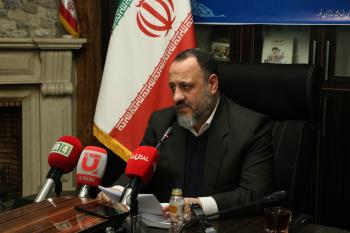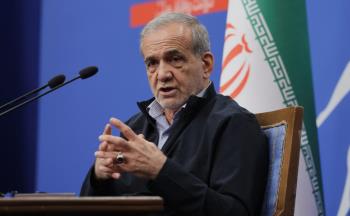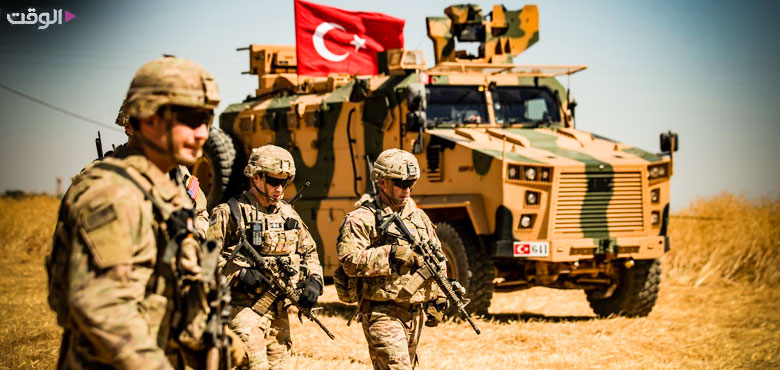Alwaght- Earlier last week, the Turkish President Recep Tayyip Erdogan announced his plan to launch a new operation in northern Syria to set up a 30-kilometer "safe zone" into Syrian territory to push away from the border the PKK and its Syrian affiliates. Following the announcement, Turkish National Security Council held a meeting headed by Erdogan, stating the need for the internal and cross-border operations to fight PKK, YPG, and ISIS.
Following the statement, Ankara-backed terrorist forces started some activities. At the same time, reports said that on May 26, a convoy of Turkish troops entered Azaz region in northwestern Syria. Although the Turkish military and its loyalist militias are on an assault mode, no timetable has been set for the operation.
Turkey's new military offensive plans in northern Syria are laid as on October 15, 2021, 2 Turkish soldiers were killed and 5 were injured in Idlib while their convoy was in the Syrian territory and the Turkish leader warned that Ankara was "losing patience" and ready for an "imminent" military action. At the time, open opposition from the US and Russia practically blocked the operation.
The new plan promotes some questions: What is Erdogan's goal? What would be Russian and the American reaction to such Turkish operation?
Turkish operations: From Operation Euphrates Shield to pushing to complete the safe corridor
The Turkish new plan is mainly meant to realize the long-held dream of establishing a safe zone with Syria. Since the beginning of the Syrian crisis in 2011, the Turkish officials have been pushing for a 30-kilometer-deep and 822-kilometer-long safe zone, namely the entire Turkish-Syrian border, which has been explicitly opposed by other actors. However, Turkey even advanced far more than 30 kilometer in some areas like Aleppo province, which was evident during the capture of Afrin in 2018. It now seems to be pursuing its dream of creating a strip along its southern borders. For clarifications on the operations, we need to shed light on the course of the Turkish military operations against the Syrian Kurds.
The first operation, Euphrates Shield, took place between August 24, 2016 and March 29, 2017, during which the areas between Jarabulus to Azaz in the north of Aleppo were captured by the militias supported by this country.
The second operation, Olive Branch, was carried out from January 20 to March 24, 2018, during which Afrin fell to Turkish forces and allied militants. During the same operation, the terrorist group Tahrir Al-Sham, formerly Al-Nusa Front, established several military bases in Idlib.
The third operation, Peace Spring, unlike two previous operations in west of the Euphrates River was launched in the eastern Euphrates. It was conducted on October 17, 2019 in order to repel the US-sponsored Syrian Kurdish militias Syrian Democratic Forces (SDF) from the border areas of Raqqa and Hasakah and ended a week later with Kurdish 32-kilometer retreat and a Washington-Ankara agreement.
In the new conditions, Ankara seeks to take control of other isolated areas on its southern borders, which are still held by the Kurds, and establish its desired security corridor in all these areas. In a possible new offensive, areas such as Manbij, Kobani, and the areas between Ras Al-Ayn and the easternmost border of Hasakah province will be targeted by Turkish military. Meanwhile, Turkey's intention to control the town of Tall Rifat and then Manbij goes beyond the 30-kilometer safe zone aim.
Operation under the excuse of resettling the Syrian refugees but for election goals
Like the past years, this time Ankara is justifying its military action by a plan to return home the Syrian refugees it hosts. Turkey says it plans to transfer to the "liberated zones" 1 million Syrian refugees. But it should be known that the refugee case is just an excuse for Erdogan and his Justice and Development Party (AKP).
As a result of the economic crisis, as well as the unity of the Turkish opposition, the position of Erdogan and his pro-government party has been severely shaken over the past two years, and all the evidence suggests that they may lose their power in the 2023 presidential and parliamentary elections. Struggling for an exit for this situation, Erdogan, as in 2018, is trying to prepare the ground for his victory in the new elections by planning a new cross-border military operation.
On the one hand, as the time for the Turkish presidential and parliamentary elections in June 2023 approaches, the issue of Syrian refugees is highlighted more and more by Erdogan. On the other hand, Erdogan is trying to re-mobilize the public in support of the AKP in the parliamentary and presidential elections with a victory in the operation in northern Syria.
Erdogan fishing in Ukraine troubled waters
The expected operation in northern Syria comes as a kind of punctual move by Erdogan to wrest privileges from the NATO members, especially the US. Ankara proposed an attack on northern Syria in 2021, which was explicitly opposed by Biden's government. But at present, the Turkish political leaders are obviously aware that because of the effects of the Russian war on Ukraine, NATO members desperately need Ankara's agreement as an effective member of the Western military alliance for Sweden and Finland membership bid.
After decades of neutrality, Sweden and Finland presented a bid for NATO membership in mid-May, but Ankara is setting up a great obstacle. According to the statute of the NATO, which currently has 30 members including 28 European countries plus the US and Canada, all members must approve the membership of new bidders. In case of opposition of even one member, the bidder will not be accepted. Therefore, Turkey's opposition means rejection of the two countries.
At this juncture, Erdogan is seizing the opportunity caused by NATO need for its agreement to establish a safe zone on its southern borders with Syria.
Russian and American stances and riddle of Turkish operation in northern Syria
Beside knowing about the US silence, the Turkish strategists also know that in the present conditions, Russia cannot effectively oppose Turkey due to its involvement in war against Ukraine. Actually, from the point of view of the AKP leaders, the current time is the best opportunity to realize safe zone plan because Moscow may reduce the number of its troops in Syria due to the conflict in Ukraine.
However, it should be noted that such an argument is in no way consistent with the field realities. As recently announced by Russian Foreign Minister Sergei Lavrov, Moscow has been in Syria since 2014 at the request of the legitimate government of the Syrian Arab Republic and the legitimate president and its mission is to implement Security Council Resolution 2254 and would continue its support to Damascus until the latter restores rule over the whole Syrian territories.
Following Lavrov's remarks, Russian forces stationed at Qamishli Airport in northeastern Syria were reinforced with new military equipment, including fighter jets and helicopters. Therefore, the Russians are resolutely opposed to any new occupation and Turkish attack on the northern Syrian border strip, and the new reinforcements are meant to counteract if case of Turkish incursion more than 30 kilometer in Hasakah.
But the US government has so far not reacted strongly to a possible Turkish invasion of northern Syria, only voicing its concern by its State Department spokesman. However, it can be stated with certainty that despite the US need for Turkish agreement for Sweden and Finland bid and for isolating Russia, it is not possible to talk about a change in the positions of Moscow and Washington regarding the Turkish military aggression.
Possible scenarios
Given the Russian and American stances, a number of scenarios can be presented. The unlikeliest scenario in the current situation is the entry of the US and Russia into a military face-off with Turkey in the event of a military operation in northern Syria. Such a scenario is unthinkable because of consequences and its unfeasibility on the ground.
Another scenario is that Washington and Russia unofficially declare a no-fly zone over Turkey's operation area. In other words, the two powers may close the skies to Turkish fighter jets and drones to show their opposition. Such a scenario is somewhat plausible, but it can also bring unpredictable consequences.
The third scenario is large-scale sanctions on Turkey by the US and the European countries. This is the likeliest scenario and has wider ground of implementation. In general, despite the Western and Russian encounter in Ukraine, they hold a united stance on the Turkish military action in north Syrian border region.



























